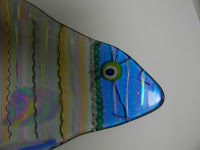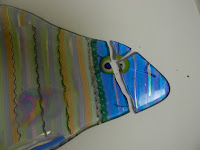Originality
is born through experimentation.
From
childhood, we’re taught to color inside the lines. But there is so much to
learn from exploring outside set boundaries.
When
planning my new webinar, Fusing for the
Adventurous, I focused on designing unique pieces that didn’t adhere to
traditional stack-and-fuse construction. I made it a point to try techniques
that would yield questionable results. I then used those techniques in
combination hoping for unexpected outcomes. My goal was to create fresh
characteristics that I could then expand on to make extraordinary pieces of
art.
When
you experiment, there are bound to be surprises along the way. Many of the
projects came out better than anticipated. Those are the pieces and methods
I’ll revisit to take farther. Some projects didn’t come out as I had hoped, but
their educational value is intact. With only minor changes to construction,
materials, or firing schedules the pieces eventually came out well.
The
best way to introduce yourself to experimenting is to start small. Next time
you have an open corner on a kiln shelf fill it with a piece that’s made using
a technique that intrigues you. I usually make the piece 2” x 2”. The piece may
be small and even ugly. That’s okay. The value lies in stretching your skills
and in seeing the results of the firing. That small success gives you the
confidence to invest more material and more time into expanding that and other
ideas. It opens a portal to new concepts and fresh designs.
Here’s
what I learned during my experimental journey.
5 Tips for successful
rebels:
1 Start with a Plan
The
most exciting experimental pieces are often complex and tedious to make.
Without a solid plan, you might be tempted to take short cuts or even quit. The
educational value is lost without completion. Allow yourself the luxury of time
and patience to follow through to the natural end.
2 Take Pictures
Before
and after pictures are priceless, especially if you’re playing with
unconventional materials. Different glasses react differently to heat.
Therefore, variations in the expected results and the actual outcome are likely.
These irregularities are welcome for the new design directions they might
suggest.
3 Take Notes
This
may seem repetitive to taking pictures, but notes are very valuable to the
success of future projects. I write my notes in a pink spiral bound note book
with glitter on the cover. The glitter is optional. Before fusing, I write down
the glass I used, the starting dimensions of the project and the color and size
of frit used, if applicable.
After
fusing, I add comments relating to the changes that occurred during firing. I
note if the shape changed unexpectedly or if a color looks different than I
planned. I include the fusing temperature and the slumping temperature, plus any
other details I think might be useful.
The
benefit of taking notes goes beyond this single project. With good notes, you
can combine techniques and accurately predict the outcome of previously untested
designs.
Another
befit to note taking is you can repeat your successes. More importantly, you
can learn from and avoid repeating failures. Plus, you don’t have to keep all
that detailed information top of mind. You’re free to welcome new project ideas
knowing the information is easily accessible.
4 Stick to the Plan
It
never fails, I’ll be in the middle of a new experimental project and the
novelty of it spurs a new purpose for the art. When that happens, I force
myself to stick to the original plan all the way to the end. I may take notes,
so I can come back to the new application, but I forge ahead.
Trust
yourself that your original idea was a good one. If you follow every tangent
that presents itself you’ll become lost in the weeds and never accomplish
anything of real value.
5 Never Give Up
Artists
that you admire were not born great. They became great through trial and error,
by pioneering innovative techniques and staying true their creative spirit. You
can too!
This
is only the beginning. There is so much potential for growth. The possibilities
and endless.
Keep
on fusing!
Lisa
Excerpt from Fusing for the Adventurous Webinar
Check out the video https://www.youtube.com/watch?v=XGT7AIRz17U
For more tips and tricks visit:
Instagram: lvogt_originalsinglass
Upcoming
Webinars and Classes
Join me for more exciting tips and techniques!
NEW Fusing
for the Adventurous Webinar
September 5, 2017
NEW Fusing
for the Adventurous Webinar
September 7, 2017
Fusing
with Frit Webinar
October 26, 2017
Creative
Slumping Webinar
January 18, 2018
Advanced
Glass Fusing Workshop
February 6 – 9, 2018
4-Days, Hands-on, Wesley Chapel, FL
Exceed
your expectations! This workshop is ideal for ambitious glass fusers determined
to go bigger and explore more in-depth kiln forming techniques! Join me in this
comprehensive, 4-day workshop and enjoy, one-on-one instruction, step-by-step
guidance to develop your own design style and an individualized project program
- make what inspires YOU! You’ll love the creative momentum you gain from working
four consecutive days. Seats size is limited. Register today!
“Lisa is an exemplary educator who is
passionate about her craft. She is highly organized and mindful of her
student’s strengths and challenges. Best practices of teaching as well as
craftsmanship were utilized throughout the workshop. Thank you for igniting my
creative spirit to a whole new level.”


















